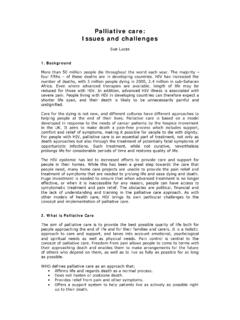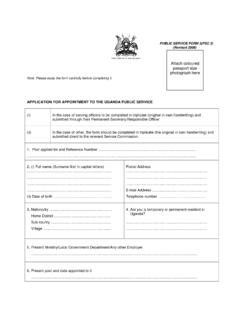Transcription of UGANDA MINISTRY OF HEALTH COVID 19 INFECTION …
1 Page 1 of 6 UGANDA MINISTRY OF HEALTH COVID -19 INFECTION PREVENTION AND CONTROL GUIDANCE FOR HIV SERVICES DELIVERY This guidance will continue to be updated as new guidance on COVID -19 evolves globally. The MINISTRY of HEALTH emphasizes the importance of maintaining critical HIV prevention, care and treatment services during COVID -19 to reduce vulnerability of PLHIV to COVID -19, ensure continuity of ART therapy and accelerated decongestion of HEALTH facilities to minimize transmission of COVID -19. A .General Considerations District Teams (Supported by the Regional Implementing Partner) o The district will maintain its role in leading the implementation of all comprehensive HIV services. o The regional Implementation Partners will work with the districts to ensure that critical HIV services are not interrupted during the COVID -19 response period.
2 They will provide the necessary technical and financial support. o District HEALTH officers and ART clinic in charges will ensure that skeletal staff is available at facilities to: attend to the clients seeking HIV and TB services in the ART clinics; record details of clients served; quantify ARVs and other drug supplies; and place emergency orders. o The districts with support from the IP should adopt the use of telephones, and internet platforms to communicate to facilities and other stakeholders, including conduct trainings and mentorships. o The districts with support from the IP will work with the existing Networks of People living with HIV to ensure the uninterrupted supply of ART to all recipients of care. Networks of PLHIV and Civil society o The PLHIV networks at national level will continue working with MoH, through the national taskforce, to coordinate the national HIV response to ensure safety of clients and uninterrupted supply of ARVs.
3 O The PLHIV networks at the district level will work with districts, through district taskforce, to monitor coordination and provide timely feedback on the quality of services during the response. o The Peer support staff at HIV service points (such as YAPs, Linkage facilitators, peer/mentor mother) should have their services at the facility suspended until the COVID 19 pandemic is under control. The PLHIV peers may work from home using phones to follow-up clients: remind them of appointments, drug pickups and linkage to nearest community ART services points. Page 2 of 6 HEALTH Facilities The facilities will display toll free and other telephone numbers for COVID -19 response teams in visible places so that Clients can save them in their phones or write them down. All ART, TB and other HIV related clinics should have functional safe thermometers.
4 All clients who come to the clinic must have their temperature taken. Use telephone calls, SMS, social media platforms to communication to clients and other stakeholders on services availability, follow up, adherence support and clinic attendance among others. HEALTH Providers will use the appropriate Personal Protective Equipment (PPE) for all staff. If a Client is suspected to have COVID -19, a gown and goggles should be used in addition to gloves and medical face mask (where feasible). Face mask and gloves are most important PPE. o ART Providers and Clients should practice frequent hand hygiene, including before and after patient care, when coming into contact with secretions, before eating and after using the toilet. o Maintain INFECTION prevention standards in the ART clinic by sanitizing all surfaces with hypochlorite per MOH guidelines.
5 O Inform MOH, relevant authorities of any suspected COVID -19 case among the ART patients. Documenting the clinical course of COVID -19 in PLHIV is important to inform optimal care. o Monitor the number of HIV and TB service providers that are tasked to work on COVID -19. Ensure continuous antiretroviral therapy (ART) provision to current recipients of care based on the available stocks of ARVs at the site in order to maintain virologic suppression. HEALTH facilities should accurately document the contact details of the clients who come to seek HEALTH services for easier follow up in case of COVID -19 exposure. Conduct on a regular basis on going activities of Information, education and communication (IEC) for the recipients of care to learn about the signs and symptoms of COVID -19 using the hand out messages, telephone calls/SMS, social media platforms and mass media.
6 Triage: o Facilities must take temperature measurements for all PLHIV clients on arrival at the clinic. o Patients presenting with fever, cough, flu like/ respiratory symptoms) should be isolated immediately and INFECTION prevention and control observed. o Screen for TB using the ICF guide at all entry points Page 3 of 6 Community activities o The general community HEALTH services including HIV testing, HIV Prevention services and TB activities are temporarily stopped as per the Presidential directive on community gatherings. Supply Chain Considerations o Facilities with inadequate stocks, should place emergency orders for ARVS. However, all facilities must ensure that sufficient stocks of drugs regimens are available during this time. Districts and partners should support inter facility and inter-district commodity transfers, where applicable.
7 Prevention services For HIV prevention, most services are community based and require mobilization using community gatherings, and or interaction with several community members. This poses a risk of exposure and transmission of the virus to the community and services providers who are mostly lay persons. Its therefore recommended that all community activities including mobilization, outreaches, meetings and workshops are temporarily put on hold. HIV testing services During this interim period, all community activities including HTS outreaches are suspended. Facility-based HTS should continue in: Testing in ANC, labor/maternity, Early infant diagnosis (EID), in patient department for diagnostic testing, people with TB, STIs, and malnutrition, Assisted Partner Notification, and index client testing.
8 Use of self-testing outside of the clinic setting should be encouraged. Safe male circumcision The community camps including community mobilization are suspended. The SMC services shall be offered as a routine service in facility on appointment to avoid crowding. The HEALTH workers offering SMC must ensure that waiting time for clients is reduced and at any one time, not more than ten (10) clients should be waiting for the service. The Post-operative follow-up for clients already circumcised should continue using telephone calls and clinic visit for clients with adverse events Community activities in Drop-in Centers (DICs), AGYW and KP/PP social interactions safe spaces AGYW safe spaces are temporally closed as per the presidential directive. The facility should focus on, line listing clients. The AGYW should continue accessing the non-curriculum-based services at the HEALTH facilities.
9 Page 4 of 6 At DICs walk in services will be provided but no more than 10 individuals should be served at any one time. Social gathering at DIC must stop in line with the Presidential directive on social distancing KPs, AGYWs and services providers are encouraged to use social media platforms for communication. Continuity of PrEP services Facilities should evaluate the stock medicines available at their sites Where stocks allow, individuals already on PrEP, should be given a 3-month drug supply. When possible, follow up and adherence support of clients on PrEP should be done using telephone, SMS, social media platforms. treatment services including PMTCT services These guidelines are aimed at reducing crowding of clients at ART delivery points as well as ensuring continued access to ART during the COVID -19 pandemic.
10 , ART delivery is majorly facility based which may potentially increase risk of the spread of the virus within the facility, therefore, focus should be placed on decongesting the facilities. Multi-month dispensing (MMD) o Multi-month dispensing (MMD) of three to six months is recommended for all clients regardless of age and viral load. This however should be based on availability of adequate ARV stock across the different drug regimens at the facility. o The Facility should systematically call all clients with scheduled clinic visit in the next month for their ART refills and viral load testing if due. o The facility should deliver ARVs to the nearest community point for clients who are not able to come to the facility. This can be through quick establishment of CDDPs. Community drug distribution o Clients receiving their care and refills through Community Drug Distribution Points (CDDPs) and Community Client Led ART Delivery (CCLADs) should continue receiving their care and refills through the same approaches.



